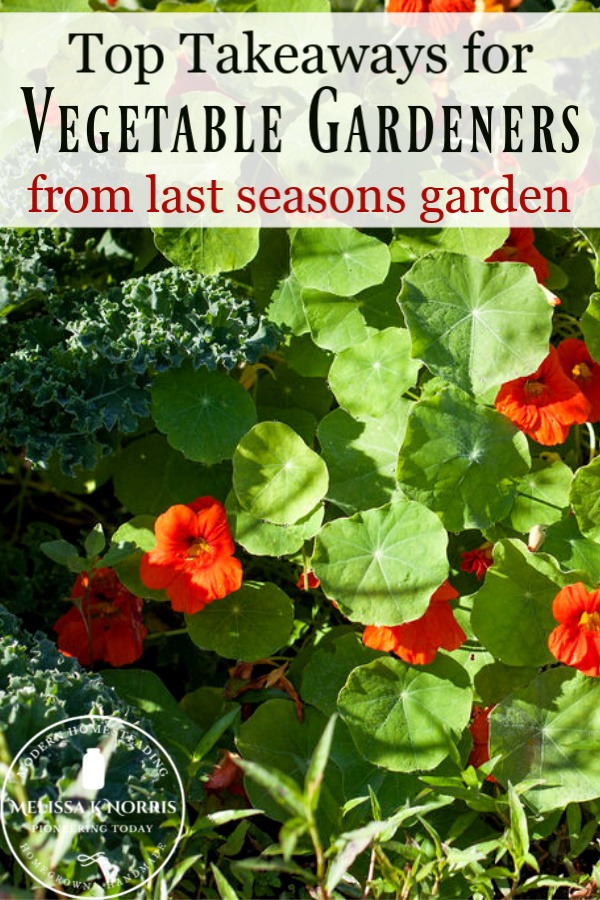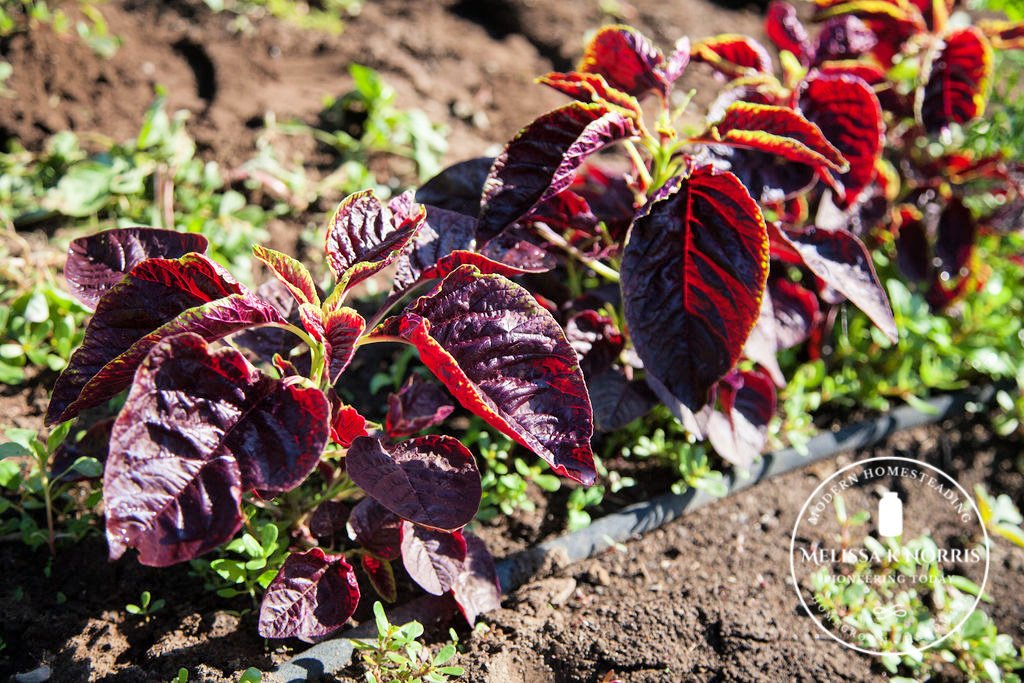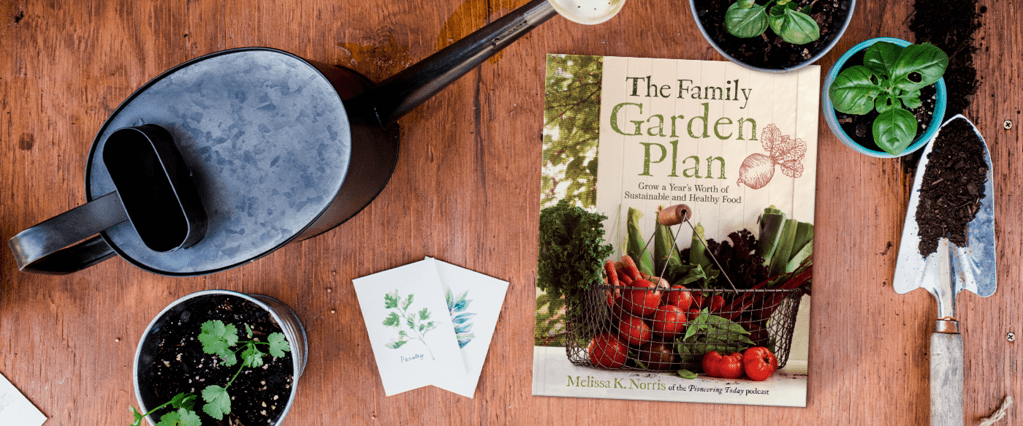My top takeaways from the vegetable gardener from this past year’s garden and how you can use the same evaluation for your garden. Why do this?
I think in all aspects of our lives it’s important we take time to reflect and to look back and analyze what went right (what we want to do more of), what didn’t go right so we know what to avoid and then some areas that we could just make some slight tweaks or changes that would make it even better.

Listen in below to the full podcast, Episode #225 Top Takeaways for Vegetable Gardeners of the Pioneering Today Podcast, where we don’t just inspire you, but give you the clear steps to create the homegrown garden, pantry, kitchen and life you want for your family and homestead.
Did you truly eat everything you planted
Get really honest with yourself if you ate most of the items you grew. If you did, awesome, keep the same varieties next year!

But, if you’re like me, you probably had a few crops you didn’t put to use as well as you should have. I tried a new type of spinach this year, a Chinese Multicolor Spinach that is supposed to be sweet and not bolt, making it a great choice for a summer growing green. You can see from the photo below it was beautiful, but we didn’t really love the flavor.
I found we didn’t eat it a whole lot. I didn’t put it to use. I would pick it every now and then and put it in a salad or if we’re doing a stir fry or something. But we really just didn’t love it that much. And I found even though it didn’t bolt as it went into the hotter months of summer, at least for me, it tended to still get a little bit of a bitter strong taste. And so then I just wasn’t using it so it wasn’t bolting, but it just wasn’t her favorite. The chickens loved it cause I would give them the extra that we weren’t eating, but I don’t think that I would grow in again as a main food crop.
The other thing that I grew that we just didn’t use a lot of was Swiss chard. It actually did very well for me. I started it, I did an early crop of it and then a later crop, and I still have some out in the garden.
I could have done more stir fry’s but remember rule number one, get honest, we didn’t eat very much of it.
Here’s the thing, you have to evaluate your garden on what you eat because I know some of you are thinking how could you not eat all your Swiss chard, we eat a ton of it.
This is one of the foundational things that I teach and share when I’m sharing how to grow your own food. And it’s one of the first things that I go over in the new book The Family Garden Plan and it’s this:
Grow more of what you eat on a regular basis.
Good thing is, on a homestead, the extra produce gets put to use as livestock feed or in the compost pile.
Using Season Extenders (my experiment with 1/2 the garden)
Why more in the fall?
My new book, The Family Garden Plan, has a lot of beautiful color photographs in it, taken on my homestead and in our gardens. If you listen to a previous episode (Episode #222 My Top 9 Homestead Gifts to Make Life Easier), you heard about that experience.
The way it worked for the timeline when a book is being published certain things have to be done and turned in in order to meet the printing and shipping deadlines, and you don’t have a lot of leeways, especially for a growing season. The photoshoot was the end of May. Most of my warm-weather crops are not even getting planted until mid-May on a warm year. A lot of times we’re actually planting Memorial weekend. You can see where that can pose a little bit of a problem if you want to have a lot to take photographs of actual produce and plants growing.
In order to have more than just seeds in the ground or tiny sprouts, I had to use more cold frames and different types than I ever had before. This worked well as a science experiment (you’ll see the different ones I used in the book) and I was able to grow and plant a lot of things at least three weeks earlier than normal.
Normally the only thing I have to do this with is my peppers and my tomatoes. The rest of the crops I’m okay with direct sowing outside, so I got to experiment with a lot of different season extenders or cold weather frames in order to get things started. We did a ton of different things, which was really fun.
I took my little infrared thermometer out in the mornings to measure the inside temperature of the different frames against the outside air and ground temperature and really get to document. This was actually really fun to see how much protection, what temps things were getting and where I could push things temperature and growing wise.
But here’s the interesting thing. I did that with about half of the amount that I would plant for each variety and then planted direct sow the other half of the crop at my normal planting time. Here’s the funny thing, because the outside temperatures were still cooler during those early four weeks, even though they sprouted and they were not killed by those frosts, they didn’t grow super fast just because it was chillier out.
The colder it is out on warm-weather crops, the slower their growth rate is. I ended up getting actual blossoms and harvestable crops at the same time. I mean maybe four or five days earlier, not a whole lot earlier really in the scope of the garden. I learned that I don’t, for the work amount of work of moving and cold frames on and off on hot days and putting them all in, setting them up, et cetera, it really wasn’t worth the extra effort for me in the beginning of the season in the early spring because my results ended up being the same on harvest dates and yield.
Using Season Extenders on Fall Crops
Using cold frames and frost protection in the fall on plants that were already planted and growing was way more beneficial. I not only extended the grow time by weeks and months, but the extended harvest yield has been amazing.
This was a pretty big thing for me because I’m still able to, right now I am still harvesting beets and normally for us, beet crops don’t last in the ground. Once we start to get hard freezes, they will rotten thought or if they’re not big enough they just stop growing, they go dormant. I’m still getting beets, and it’s December you guys, out of the ground and normally I am done in October with beats.
This might have been my biggest takeaway!
Adjust your planting dates
I need to plant my fall crops one to two weeks earlier in the summer to get a better harvest. I planted most of my fall crops the first and second weeks of August and that worked really well for the majority of my brassicas. So that worked great for the cabbage. It worked very well for the bok choy and cabbage. But the broccoli and especially the cauliflower, some of them we got too cold before they had really been able to form much of a head. If they’d had just an extra week of slightly warmer weather they would have been a perfect size.
The weeding method that worked the best
My next takeaway was this has to do with the weeds. Much as I love gardening, I actually find weeding therapeutic to a degree, it’s not my favorite thing to do and it can become overwhelming and it can easily kind of take over really quick and then you’re like, Oh my goodness, how am I going to get caught up on this?
This year we did more mulching than we have done in previous years. And I’m still testing on my garden on the annual vegetable garden. Half of it I did with the wood chips and half of it without, and I did soil tests before I put the wood chips down. So I had something to measure by and I’ll be soil testing again this spring. I’m not sure yet the results on if I am going to mulch my entire garden with wood chips, it’s still out. I haven’t decided yet.
I did more mulching overall than I think I’ve ever done in any other gardening year.
But before I mulched I weeded really well. I pulled up larger weeds and I disrupted the top surface of the soil with a rake if anything was starting to sprout.
Weeds did come up. Mulch does not stop weeds altogether, but it does definitely minimize them and it does some other great things for the soil. When the weeds came up I was diligent on pulling them out before they took hold. It only took about 10 minutes on most days. Some days were maybe a little bit longer. And I’m talking like all of the beds.
The greenhouse, the annual vegetable garden, my perennial rows of asparagus, blueberries, raspberries, elderberries, my flower beds, and my herb beds. I rotated through each area over the week. I tried to make sure at least five days a week that I was doing rotating through what we were weeding.
It made such a difference just keeping up on the weeds like that one. It made it very manageable for me to do, but second, because I was staying on top of it, I didn’t have as many weeds that were going to seed and then spreading more or sending out their renters depending on the type of weed and how it spreads.
This fall I weeded again right before our killing frost. I will definitely use this method next year and should have even fewer weeds! Of course, some weeds are edible and have great medicinal properties, more on that here Episode #142 Edible & Medicinal Weeds in Your Backyard– How to Harvest, Cook & Preserve Them
Disease Prevention
This past year we actually were a little bit wetter and cooler than an average summer in the Pacific Northwest. I always prune my tomatoes, berry bushes and fruit trees, but I don’t normally prune my squash plants.
This year we got hit hard with downy and powdery mildew. We only use organic and natural methods in our garden (you’ll find a whole section and charts on this in The Family Garden Plan) and milk or whey can be used on mildew. You can also use copper, which is an organic fungicide option. But honestly, prevention is the best medicine and is really the best thing that you can do.

This year I am going to prune my squash, in hopes I can stop or keep it from coming back or spreading if it does. I noticed and you’ve probably noticed this too, the first big leaves that form at the base of the squash plant before it begins to totally vine out your oldest, most mature leaves. Those ones for me tend to be where I first notice the signs of powdery and or Downy mildew.
I plan on pruning out some of these large leaves to help with airflow and help head off any onset of the diseases.
Plant more of what brings you joy
I want more flowers. I’ve not always had flowers in the vegetable garden.
It’s only been the past four years I’ve started using annual flowers in the vegetable garden and my landscape. Some favorites are calendula, nasturtiums, and marigolds as companion plants, medicinal (calendula and nasturtium), and their beauty.
But now I’m adding in flowers even if they don’t serve a medicinal purpose, simply because I think they’re beautiful. Check out Episode #186 How to Design a Cottage Garden Forgotten Medicinal & Edible Plants with Carolyn from Homesteading Family for more info on this!
Want more help on planning out next year’s garden?
Join the Best Garden Plan Challenge
I’m giving you five days worth of videos to help you plan your best garden ever, totally free. Each day you’ll get a link to the video where I walk you through step by step so it’s easy and bit-sized chunks that you can do. By the end of it, you will have a customized garden plan for your specific growing area, your climate, size of your family and the foods that your family loves and eats the most. I’ll help break down the steps to help get rid of the overwhelm and I’ll give you my best tips and strategies to make that happen, including free worksheets and charts.
Every day of the workshop I’ll send you an email that will include a link to the session AND I’ll be live during the video session so as we’re going through it, you can ask me questions. Does this sound like something you’d be interested in? If so, register for the 5 Day Best Garden Plan Challenge today. It starts on December 30th! You’ll still be able to register after the 30th and go through the challenge, but you’ll want to go through it live with me so that we can go through it as a community.
Preorder my new book today The Family Garden Plan to take advantage of all the bonuses! In this book, you’ll learn how to grow a year’s worth of food for your family! Increase your harvest and maximize the space you have using organic and natural methods to raise a year’s worth of the fruits and vegetables your family enjoys with Melissa’s step-by-step plans and charts.
If you’ve already ordered the book (thank you so much!) claim the bonuses by clicking here and then click the Get My Bonus Now button. Simply fill in the short form with your name, email and receipt number. I’ll then send you the bonuses, both the Crop Rotation and Companion Planting videos to visually walk you through how to do it in your own garden. You’ll also receive my Seed Saving 101 Video and e-book Package as well as the Organic Soil Amendment Guide. This guide alone is so in-depth and walks you through how to identify when your soil might be low, what your plants will exhibit, etc. This is especially helpful if you’ve not done a soil test but you’re experiencing issues stemming from poor soil nutrition.




